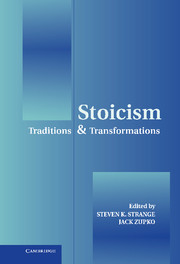Book contents
- Frontmatter
- Contents
- List of Contributors
- Acknowledgments
- List of Abbreviations
- Stoicism
- Introduction
- 1 The Socratic Imprint on Epictetus' Philosophy
- 2 The Stoics on the Voluntariness of the Passions
- 3 Stoicism in the Apostle Paul: A Philosophical Reading
- 4 Moral Judgment in Seneca
- 5 Stoic First Movements in Christianity
- 6 Where Were the Stoics in the Late Middle Ages?
- 7 Abelard's Stoicism and Its Consequences
- 8 Constancy and Coherence
- 9 On the Happy Life: Descartes vis-à-vis Seneca
- 10 Psychotherapy and Moral Perfection: Spinoza and the Stoics on the Prospect of Happiness
- 11 Duties of Justice, Duties of Material Aid: Cicero's Problematic Legacy
- 12 Stoic Emotion
- Works Cited
- Name Index
- Subject Index
3 - Stoicism in the Apostle Paul: A Philosophical Reading
Published online by Cambridge University Press: 11 July 2009
- Frontmatter
- Contents
- List of Contributors
- Acknowledgments
- List of Abbreviations
- Stoicism
- Introduction
- 1 The Socratic Imprint on Epictetus' Philosophy
- 2 The Stoics on the Voluntariness of the Passions
- 3 Stoicism in the Apostle Paul: A Philosophical Reading
- 4 Moral Judgment in Seneca
- 5 Stoic First Movements in Christianity
- 6 Where Were the Stoics in the Late Middle Ages?
- 7 Abelard's Stoicism and Its Consequences
- 8 Constancy and Coherence
- 9 On the Happy Life: Descartes vis-à-vis Seneca
- 10 Psychotherapy and Moral Perfection: Spinoza and the Stoics on the Prospect of Happiness
- 11 Duties of Justice, Duties of Material Aid: Cicero's Problematic Legacy
- 12 Stoic Emotion
- Works Cited
- Name Index
- Subject Index
Summary
In 1949 Max Pohlenz, the doyen of early twentieth-century German scholarship on Stoicism, published an article, “Paulus und die Stoa,” in which he discussed the first few chapters of the apostle's letter to the Romans and the Christian historian Luke's account of Paul's speech on the Areopagus in chapter 17 of the Acts of the Apostles. Pohlenz was asking about the Stoic credentials of various ideas in the two texts. He concluded that in Paul there was nothing that went directly back to Stoicism. Instead, any Stoic-sounding ideas had come to Paul through Jewish traditions that would rather reflect some form of middle Platonism. In Luke, by contrast, there is a direct reminiscence of Posidonius.
In 1989 Abraham J. Malherbe, Buckingham Professor of the New Testament at Yale Divinity School, published a book, Paul and the Popular Philosophers. He argued that in a number of individual passages in the letters, Paul was interacting directly with specific motifs derived from the moral exhortation of philosophers like the Cynics, Stoics, and Epicureans. Paul need not have read, for instance, Chrysippus. But he had an easy familiarity with the moral discourse of the “popular philosophers” of his own time, as exemplified to us by his near contemporaries Seneca, Dio Chrysostom, and Epictetus.
In Paul and the Stoics (2000), I argued that Paul is relying on central ideas in Stoicism even when he states the core of his own theological thought. This development should be of some interest to students of Stoicism.
- Type
- Chapter
- Information
- StoicismTraditions and Transformations, pp. 52 - 75Publisher: Cambridge University PressPrint publication year: 2004
- 4
- Cited by



